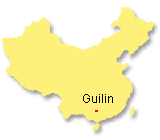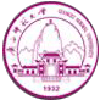Guilin Life
Guilin's scenery is unique both to China and to the rest of the world. Emerging from a flat green plane laced with rivers and lakes the Karst formations are steep, rounded towers of stone which stand in a line like battlements. This bizarre range of peaks has caused Guilin to be immortalized in Chinese painting and poetry. The celebrated Tang Dynasty poet Han Yu (768-824) described the region this way: "The river forms a green silk belt, the mountains are like blue jade hairpins."The Karst formations were thrust up from the limestone sea bed which covered the region some 300 million years ago. Eroded over centuries by the area's unique wind and water conditions, this "stone forest," with its many subterranean caves and rivers, creates a haunting atmosphere. The stunning landscape in Guilin has a kind of magic that is all its own. The strangely shaped hills, or Karsts, with the verdant vegetation ranging from bamboo to conifers together with wonderful caves make Guilin such an attraction for tourists. The landscape in Guilin is remarkable. The natural wonders, the song & dance of local ethnic minorities and the leisurely Li River Cruise allow tourists to relax and enjoy the picturesque sights of the city.
At the height of the Tang Dynasty, Guilin had become a relatively large city with great halls and walls. During the Song Dynasty, Guilin was the capital of Guangnanxilu, which governed Guangxi and Hainan Island. In the Ming Dynasty, Guilin was also the seat of Jingjiang Prince Mansion and Guangxi Three Departments. Emperor Yongli had been here twice. Canals were built through the city of Guilin so that food supplies could be directly transported from the food-productive Yangtze plain to the farthest southwestern point of the empire. The first Westerners ever to see Guilin were Portuguese sailors taken prisoner by the Ming government in 1550. In 1644, when the Manchu's came to power, the retreating Ming made Guilin their capital. In 1921, Guilin became one of the headquarters of the Northern Expeditionary Army led by Dr. Sun Yat-Sen who had set up his residence here and directed the northward expedition. It remained a provincial capital until 1912 and briefly became the national capital again in 1936. In the wake of the Japanese invasion of the 1930s, the exodus of Chinese nationals from northeastern China caused Guilin's population to expand from 100,000 to over one million. Hundreds of Western missionaries also sought refuge here. In 1940 Guilin was reset as a city and the capital of Guangxi Province. In 1981, this ancient city was listed by the State Council as one of the four cities (the other three being Beijing, Hangzhou and Suzhou) under the protection of historical and cultural heritage, as well as natural scenery, should be treated as a priority project.
Guilin rests of Karst topography which is a three-dimensional landscape shaped by the dissolution of a soluble layer or layers of bedrock, usually carbonate rock such as limestone or dolomite. The landscapes display distinctive surface features and underground drainages, and in some examples there may be little or no surface drainage. The name Guilin translates to "Cassia Tree Forest" because of the abundance of native Cassia trees. In the fall months, this tree releases the most wonderful, sweet fragrance that gentle flows throughout the city for all to enjoy. The city is rather compact when compared with other leading cities in the country. However, situated within this area one may find green mountains, crystal clear waters, unique caves and beautiful stones.
Tourism, agriculture and industrial sectors constitute the mainstay of Guilin's economy. Tourism is the main engine responsible for driving Guilin's economic growth. Since the government decided to develop Guilin as a major tourist attraction in the late 1970s, many of the heavy industries have been moved into outlying regions. The recent improvement of Guilin's modern industrial capacity has also contributed to the city's prosperity. Guilin mainly produces nitrogen fertilizers, spun silk, cotton cloth, tires, medicines, rubber, machinery, and a wide range of other items such as pharmaceutical goods, herbal medicine, tires, fertilizer, silk, perfume, wine, tea, cinnamon, textile, weaving, writing brush, chemistry, cement and pharmacy, etc. Machine tool manufacturing gained prominence here during the Cultural Revolution
and today the city also supplies the country with iron equipment, electronic
components, semi-conductors and transistor radios. Traditional commodities
still produced here include wine, bean products, candy, pepper sauce, bamboo
chopsticks, and umbrellas.
The scenery in Guilin is among the most beautiful in all of China. The hills are the most magnificent green, the fields colorful, and the pinnacles unique and intriguing. The Li River also winds its way through the city. Both sides of the river are lined with many green hills that seem to spring up from the ground as though a crop growing. This entire area is poetic and tranquil. The colorful ethnic background lends a touch of mystery that enhances its fame. The many ethnic minorities represented here include the Zhuang, Yao, Hui, Miao, Mulao, Maonan and Dong. These many minorities enrich the cultural life of the city. Each minority has its own unique customs and festivals which means that they are much more abundant here than in many other places elsewhere in China. Travelers can enjoy these pageants at the Li River Folk Customs Center. Major attractions include Elephant Trunk Hill, Li River, Reed Flute Cave and Seven-Star Park that boasts a Stone Museum where amazing geological finds are displayed. |

 Guilin is one of China's most picturesque cities, with a population of 670,000
and situated in the northeast of the Guangxi Zhuang Autonomous Region on the
west bank of the Lijiang River (also called the Li River). Its name means "forest
of Sweet Osmanthus", due to the large number of fragrant Sweet Osmanthus
trees located in the city. There is a famous Chinese saying "Guilin's
scenery is best among all
under heaven." Other than Han, there are several non-Han minority
ethnic groups who populate this area who include Zhuang, Yao, Hui, Miao, and
Dong.
Guilin is one of China's most picturesque cities, with a population of 670,000
and situated in the northeast of the Guangxi Zhuang Autonomous Region on the
west bank of the Lijiang River (also called the Li River). Its name means "forest
of Sweet Osmanthus", due to the large number of fragrant Sweet Osmanthus
trees located in the city. There is a famous Chinese saying "Guilin's
scenery is best among all
under heaven." Other than Han, there are several non-Han minority
ethnic groups who populate this area who include Zhuang, Yao, Hui, Miao, and
Dong.  Guilin is an important cultural city with a history
encompassing more than 2000 years. Guilin has been the political,
economic and cultural center in northeast Gui Region ever since
its founding. Guilin was first established by Emperor Qinshihuang
(214 BC) as the Guilin Shire. It was located on the Guixiang
"Corridor" which was an important passage connecting
Zhongyuan and Lingnan. During the Three-Kingdom period, the Wu
Kingdom built up Shi'an Shire here, and from then on Guilin has
come to be a political and transition center.
Guilin is an important cultural city with a history
encompassing more than 2000 years. Guilin has been the political,
economic and cultural center in northeast Gui Region ever since
its founding. Guilin was first established by Emperor Qinshihuang
(214 BC) as the Guilin Shire. It was located on the Guixiang
"Corridor" which was an important passage connecting
Zhongyuan and Lingnan. During the Three-Kingdom period, the Wu
Kingdom built up Shi'an Shire here, and from then on Guilin has
come to be a political and transition center. 
